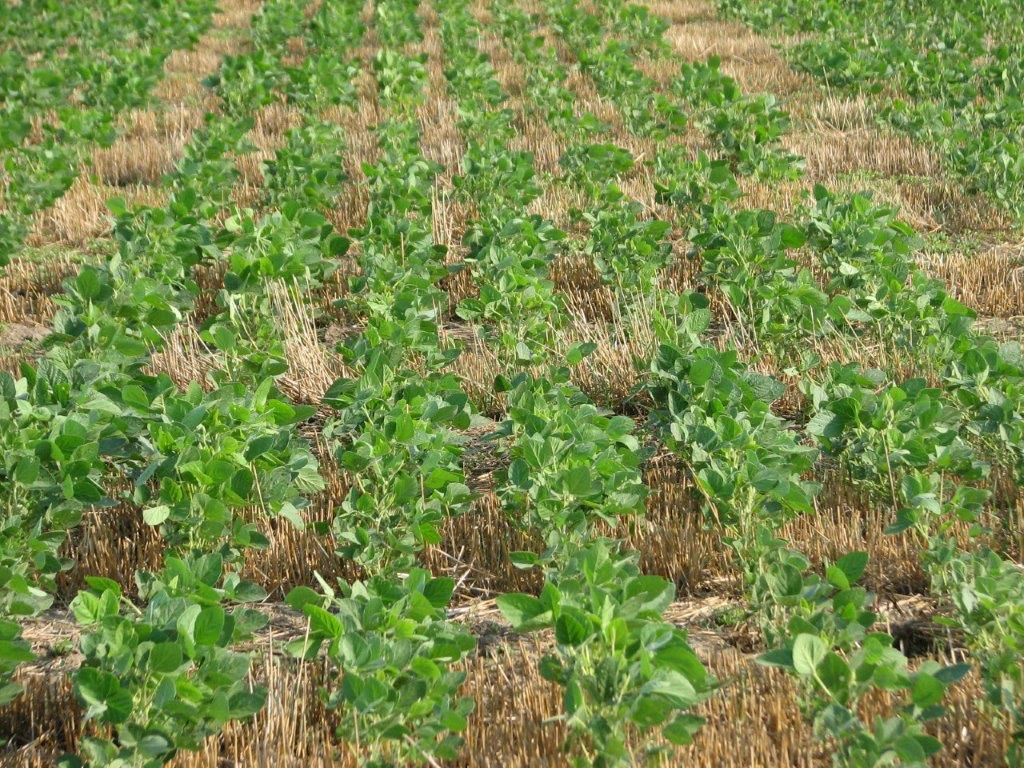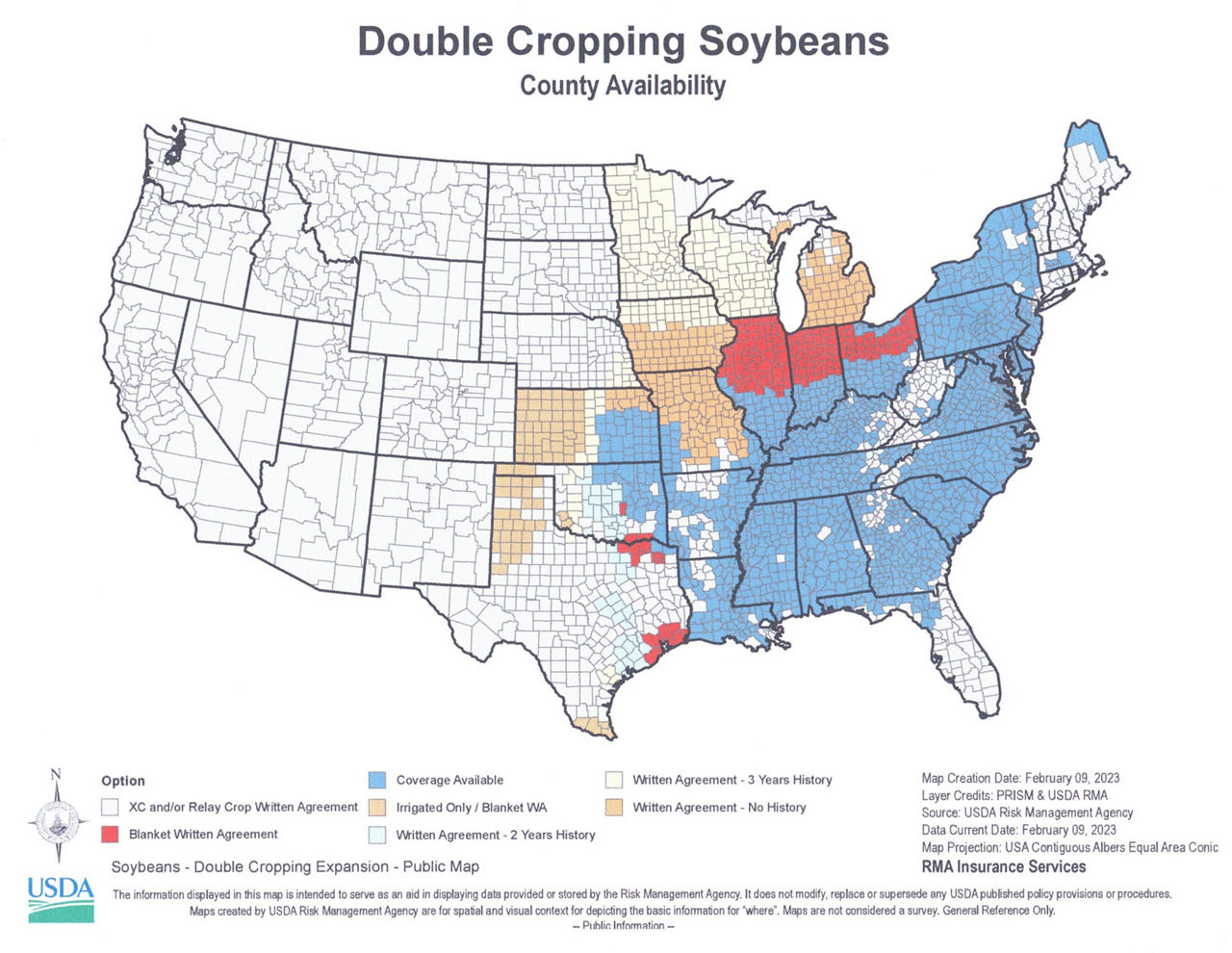5 MIN READ
Double-Cropping Soybeans After Wheat
May 9, 2025
KEY POINTS
- A successful double-crop soybean production system begins by planting as soon after wheat harvest as possible.
- Residue management during the wheat harvest is also very important.
- Selecting later-flowering soybean products helps to improve the chance that double-crop soybeans will produce enough foliage and nodes to fill more pods before frost.
- Controlling insects, diseases, and weeds can improve the chance that double-crop soybean will produce anticipated yields despite a shortened growing season.
Cultural Practices
Planting a soybean crop after wheat harvest presents the grower with several production challenges. The growing season is shorter, wheat residue may require management, weather can be unpredictable, and rapidly growing weeds like Palmer amaranth can complicate production.
The most important challenge associated with growing double-crop soybean is soil moisture. A soybean seed imbibes approximately 50% of its weight in water, so adequate topsoil moisture is essential for germination and stand establishment. The problem can become greater in sandy soils with lower water holding capacity. In fields with irrigation, soil moisture can be managed, though timely irrigation applications are needed for good seed germination and throughout the shortened crop growing season. In rainfed situations, if subsoil moisture is limited, the crop will be almost completely dependent on timely rainfall for the remainder of the growing season.1 Any water stress during the shortened growing season in a double-crop system can have substantial negative impacts on production.
Another key challenge to manage is that the soybean crop must produce leaf area quickly enough to fill pods before a killing frost. The primary way to help manage this challenge is planting double-crop soybean as soon after wheat harvest as possible. Every day lost by a delay in planting reduces the time the crop has for vegetative growth prior to reproductive growth. Soybean plants are photoperiod sensitive and shift from vegetative to reproductive growth when daylength shortens. The timing depends on the maturity rating of the soybean, with later-maturing varieties shifting to reproductive growth later in the growing season. A later-maturing soybean is often planted in double-crop soybean systems to help extend the vegetative growth period, which can be helpful for producing a profitable double-crop. Increasing the seeding rate by 10 to 15% can also increase the number of nodes and pods per acre to help increase the yield potential of this late-planted crop.2 Ohio State University recommends targeting a harvest stand of 180,000 plants/acre for soybean planted in early July.3
An early wheat harvest can extend the window for planting double-crop soybean. For double-cropping, harvesting wheat at a slightly higher moisture content and drying the grain may be more beneficial than waiting for wheat to reach 13% moisture content in the field. Harvesting wheat at 18 to 20% moisture content does not appear to affect the milling or baking quality but will result in drying costs, or dockage may be assessed when selling high-moisture grain.2 A study in Kentucky found that harvesting wheat in the moisture content range of 20 to 22% followed immediately by planting resulted in soybean yield increases of 8 to 12 bu/acre compared to soybean planted after wheat harvested at 13 to 15% grain moisture.1
Narrow row spacing of 7.5 or 15 inches is often recommended for late planting. Narrow rows allow more sunlight to be captured, driving photosynthesis and speeding canopy closure, which may assist in weed suppression. However, the trade-off might be that planting in wider rows can result in the bottom pods being set higher than in narrow rows, and higher pods can help facilitate harvesting.4

Figure 1. Narrow row, no till, double-crop soybean crop.
No-till planting into wheat residue can save time and help retain soil moisture; however, planting into wheat residue can be challenging. Cutting the wheat crop higher than usual or using a stripper header coupled with uniformly spreading residue behind the combine can help mitigate planting problems. Windrowing residue should only be done if the residue is baled and removed, which will delay soybean planting. The wheat residue can help reduce weed pressure at soybean emergence and help reduce soil temperature for mid-summer planting dates when soil temperatures can be high. Tall residue may also help soybean to set pods higher off the ground which, as mentioned above, can help minimize harvest losses. Planters should be equipped with row cleaners and/or coulters that can cut through wheat residue and penetrate the soil to the desired seeding depth. Consistent seeding depth along with planting into a residue-free zone is critical for good seed-soil contact and uniform emergence. Dry conditions at planting require planting deeper to help get the seed into adequate moisture for germination.
Weed Management
The same environmental conditions that are ideal for quick emergence and growth for double-crop soybean are also ideal for weed growth. Some difficult-to-control weeds like Palmer amaranth can grow well even in hot, dry conditions. Beginning with a weed-free seedbed is critical. Pre-emergence herbicides should be used to prevent weeds from emerging with the planted soybean. Narrower row spacing can help limit plant stress and increase yield potential by closing the canopy faster, reducing weed pressure and soil temperature.
Soybean Product Selection
One key to achieving the necessary plant growth is selecting a later-maturing soybean product. Later-maturing soybean should have more time to produce adequate leaf area and nodes for pod formation, providing a yield advantage if the crop can mature before a killing frost. In most cases, growers select a soybean product that is one or two maturity group gradations higher than what they would have planted as a full-season soybean. Some soybean products perform better than others in the same maturity group when planted in a double-crop system, so consulting with your local seed advisor is important to find the best double-crop soybean products for your area. Some states may also have data from official variety tests (OVT) for full-season and double-crop soybean, so check for these types of tests in your area.
Use sulfonylurea ready (SR) or sulfonylurea tolerant soybean (STS®) soybean products if sulfonylurea herbicides were used for weed control in the wheat crop. This trait can help prevent injury in the double-crop soybean, as sulfonylurea herbicides would otherwise inhibit the ALS (acetolactate synthase) enzyme, which plays an important role in forming necessary proteins for the plant’s growth and development. Since this class of herbicides is degraded by hydrolysis—by moisture in the soil—dry weather can potentially cause more carryover problems. The natural breakdown of the herbicide can also be delayed in environments with cooler weather and higher pH soils. These conditions could increase the potential for injury in the double-crop soybean because of higher residual amounts of herbicide in the soil.5

Figure 2. ALS injury to soybean leaf.
Disease and Insect Management
Because double-crop soybean is planted later in the season, plants may face more insect pressure at earlier growth stages than a full-season soybean crop. A three-year research study conducted by Mississippi State University concluded that applying an insecticide seed treatment resulted in about a 2.4 bu/acre yield advantage, regardless of maturity group, location, or month planted, and the average response did not change much based on yield potential.6 Growers should always scout and apply additional fungicides and insecticides as needed to maintain soybean condition throughout the growing season.
Crop Insurance
Crop insurance availability for double-crop systems has been a problem historically. In recent years, the United States government expanded the number of counties eligible for double-crop crop insurance (Figure 3).7 Now a grower can potentially sign a written agreement (depending on the county where the double-crop will be planted) with the USDA Risk Management Agency (RMA) to provide coverage for the double-crop acres in production. These potential deviations might change how Actual Production History (APH) yields are calculated, so understanding how these changes might affect USDA payments can influence the decision to start double-cropping.8 Always consult your local USDA office and your local crop insurance provider to see how any system changes and production practices may affect your farm’s eligibility for farm programs or crop insurance.

Figure 3. USDA 2024 map of soybean double-cropping expansion.7
Sources
1Anderson, E., Pennington, D., and Dong, Y. 2024. Considering double-crop soybeans after a winter cereal this year? Michigan State University Extension. https://www.canr.msu.edu/news/considering-double-crop-soybeans-after-a-winter-cereal-this-year
2Brown, C. 2019. Improving yield in double-cropped soybeans. Soybean Research & Information Network. https://soybeanresearchinfo.com/research-highlight/improving-yield-in-double-cropped-soybeans/
3Lindsey, L. Double crop soybean production guidelines. Ohio State University Extension. https://stepupsoy.osu.edu/sites/hcs-soy/files/double%20crop%20soybean%20production.pdf
42018. Double crop options after wheat. No-Till Farmer, from Kansas State University. https://www.no-tillfarmer.com/articles/7968-double-crop-options-after-wheat
5Niver, R. 2020. What STS means and why you should care. Illinois Soybean Association, Illinois Soybean Advisor. https://www.ilsoyadvisor.com/what-sts-means-and-why-you-should-care/
6Catchot, A., Cook, D., and Gore, J. 2013. Do insecticide seed treatments provide any value on late planted soybeans? Mississippi State University Extension. https://www.mississippi-crops.com/2013/05/17/do-insecticide-seed-treatments-provide-any-value-on-late-planted-soybeans/
7Double cropping initiative. Risk Management Agency, United States Department of Agriculture. https://www.rma.usda.gov/about-crop-insurance/highlighted-initiatives-plans/double-cropping
82022. Double cropping beneficial to farmers. The Soy Hopper, Checkoff News. https://www.unitedsoybean.org/hopper/double-cropping-beneficial-to-farmers/
Web sources verified 5/5/25. 1314_95008
To salvage as much of the growing season as possible, farmers must be prepared to plant immediately behind the wheat combine.
“The biggest hurdle we run into is getting the soybean plants big enough, quick enough, to provide the energy necessary to fill the pods before we get a frost." says Jim Dunphy, Extension Soybean Specialist, North Carolina State University. “We’re typically planting relatively late, and we’re planting a crop that is sensitive to day length. Late-planted soybeans simply don’t have as much time to get big enough. " “We want to get the soybeans up and growing quickly, so they have the best chance of growing large enough so the plants are lapping in the middles and plants have 4 layers of leaves before they flower, Dunphy says. “The goal is to produce enough leaves to capture as much sunlight as possible.